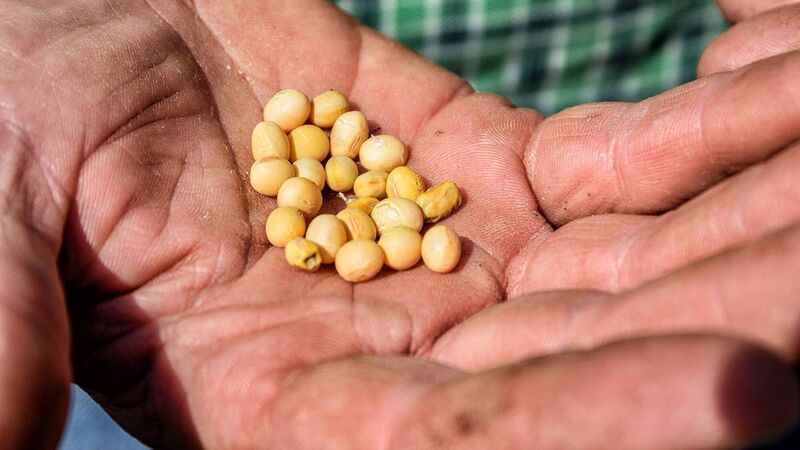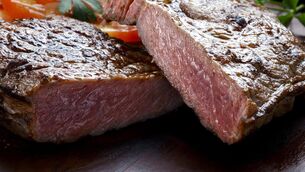US soya bean farmers left exposed in Trump's tariff wars

More than 500,000 American farmers grow soya beans, and there are hundreds of thousands of soya bean industry jobs.
Farmers worldwide are in the frontline of Donald Trump’s trade war.
Perhaps the most nervous of all are the soya bean growers of Louisiana.
They supply 82.5% of American soya bean exports to the EU. There will be a 25% EU duty on these soya bean imports, unless trade negotiations with the US go well.
Trump’s tariffs threaten the American soya bean success story more than most commodities.
The US is the second-largest exporter of soya beans globally, selling more than half its yield to about 80 countries, in a trade worth more than $27bn per year.
More than 500,000 American farmers grow soya beans, and there are hundreds of thousands of soya bean industry jobs.
But they may have nowhere to go with half of the crop, if tariff negotiations go badly.
China is by far the most important market for US soya, importing $15bn worth. But Trump's tariffs have left China and the US at each other's throats, the world’s two largest economies seemingly prepared to halt bilateral trade if negotiations are not successful, with Chinese officials prepared to “fight to the end” against Trump's 104% import tariff on Chinese goods.

As it stands, American soya bean exports will face a 94% tariff in China. In recent years, China increasingly turned from the US towards Brazil for its soya imports, and now imports three times more soya (by value) from Brazil than from the US. China night now shut the door on US soya.
Another big importer, Mexico, may also reject American soya, unless trade negotiations with the US go well.
What a dilemma for farmers across the USA, who are currently planting soya beans?
It's a dilemma also for politicians such as Republican House Speaker Mike Johnson, a Trump tariff supporter who represents Louisiana (where the poultry industry is also targeted by EU tariff retaliation, along with beef from Kansas and Nebraska, and wood products from North Carolina, Georgia and Alabama).
Along with soya bean growers, a Trump trade war would expose the US dairy industry, principally because it exports more than 50% of its dry whey and lactose production, with China as the largest buyer.
A trade fallout threatens to obliterate that trade (which could present a big export opportunity for the EU to replace the US exporters).
That could halt the US dairy sector's export growth, from less than 2% of US milk production in the early 2000s, to nearly 20% in recent years. This threat is already reflected in falling prices in US dairy futures. So, profit margins may be squeezed further on US dairy farms.
Falling feed and grain prices might help them, due to trade war impacts on American grain and oilseed exports. But that would be at the expense of US growers of soya and other crops, who are already under pressure from years of low prices.
Overall, retaliatory measures imposed by China, Canada and the EU could hit nearly $90bn of American exports. Many of these measures are purposefully targeted at states that supported Trump in the presidential election.
This includes chicken, wheat, other meats, fruit, soya beans, and maize targeted for Chinese retaliation. And Canada threatens 25% tariffs on a range of American agrifood products.
As trade war clouds gather, Irish beef farmers currently enjoying high prices can be relieved that the once much-vaunted prospect of exporting Irish beef to the US never came to much. But there could be other collateral damage in a trade war, for example, if a 20% tariff on EU goods going to the US leaves excess supply on the EU market, putting pressure on prices.
The same could happen on the global meat markets, if they are swamped by excess product from Canada, Mexico, and Australia, shut out of the USA by tariffs.
That could lead the EU and others to introduce anti-dumping measures against goods from China and others to protect EU producers. That is one of the ways a trade war could go global. Another is the US forcing countries to adopt a worldwide tariff against China.
That could be an ultimate objective for Trump's aggressive tactics, along with targeting non-tariff weapons (such as the EU's regulations and taxes like Vat, or even our ban on hormone-treated meat and genetically modified crops from the US).
Nor can the damage caused by global uncertainty triggered by Trump be underestimated, hanging over trading and inevitably causing economic slowdown.
"What next" is on the lips of anyone involved in international trading, after Trump last week abruptly paused much of his tariff assault on trading partners for 90 days, but pushed tariffs on Chinese goods up to 125%.
A 10% tariff on almost all US imports remained in effect (even though some come from countries that import more from America than they export to it). But the 90-day pause allows room for trade partners that agreed to negotiate, including the EU, facing Trump’s 20% tariff on all EU exports, and 25% on EU cars, with tariffs on EU pharmaceuticals also expected.
Trump said he hoped to strike a deal with China. But he also seems to want tariffs bringing in trillions of dollars and bringing companies back to the USA, which limits negotiating space.
In Trump’s first presidency, China and Europe quickly met Trump's tariffs with strong retaliatory measures of their own. That may happen again, supported by surging anti-American nationalism around the world.
Amid the uncertainty, the only people happy were those who Trump publicly advised to buy stocks, when the stock market plunged more than 10% after he announced tariffs on April 2. Those able to buy in were relieved when stocks gained by 8% to 12% after Trump last week paused much of his tariff assault for 90 days.













